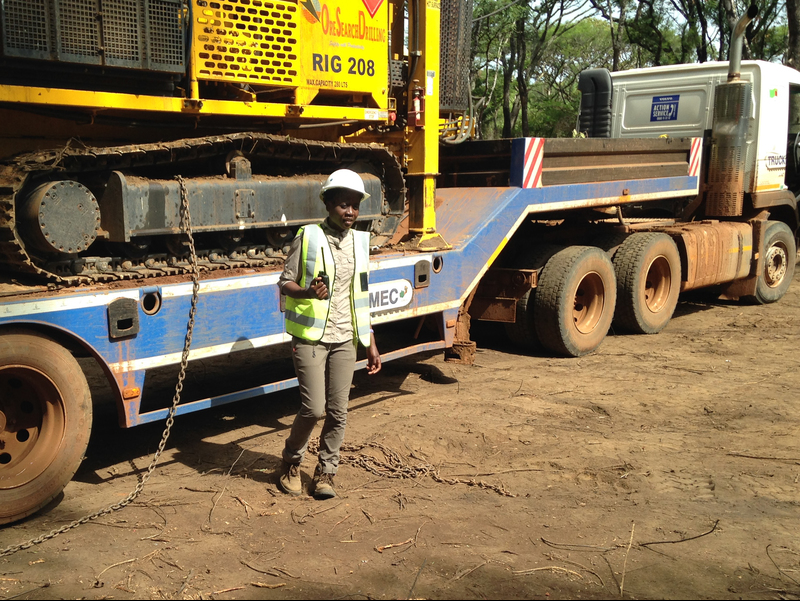Mining for sustainable development
31 May 2017 | Story Chido Mbambe. Photo Supplied.
The African Development Bank (AfDB) has sponsored a project dedicated to education for sustainable development in natural mineral resources management. The selected students’ research has a focus on gender equity.
Kabang’u Sakuwaha is a geoscientist working in mineral exploration for Rio Tinto Zambia, one of the world’s largest metals and mining corporations. She is also currently completing her MPhil in sustainable mineral resources development at UCT. And now she has received a grant from the AfDB to write commissioned papers on topics of mining and sustainable development goals.
After completing her primary and secondary schooling, Sakuwaha enrolled at the University of Zambia (UNZA) in the School of Natural Sciences and then went on to major in geology. She graduated top of her class in September 2012 and started work in uranium exploration immediately.
“I grew up in a big family and that taught me that there is no substitute for hard work,” she says. “In 2015 I saw an advert for the MPhil programme at UNZA and applied for it, so here I am.”
The MPhil programme she was interested in was initially being offered multi-institutionally by UNZA, UCT and Stellenbosch University. Sakuwaha chose to enrol as a UNZA student, but once her coursework was completed she applied to transfer to UCT for the remainder of the programme.
“I was drawn to the fact that UCT is Africa’s number one university; I wanted to experience the best and I’ve enjoyed it,” she says. “I love that research is taken so seriously and there is a lot of support for it.”
Although Sakuwaha always thought she would be an electrical engineer, seminars held by lecturers in the Department of Geology at UNZA to encourage first-year students to study geology persuaded her otherwise. A number of mines in Zambia had also just reopened following increased investments in the industry. This came after a long period of poor performance and mine closures.
“Career prospects looked quite bright and interesting as I learnt that geology is applicable in a wide range of areas,” she says.
As a geologist working in mineral exploration, her job offers her diversity.
“Exploration projects typically proceed episodically and seasonally, with periods of intense activity such as drilling, separated by periods when there is little or no activity. We travel a lot and usually to remote areas with little or no cellphone coverage,” she explains.
African Development Bank focus on gender equity
The African Development Bank believes that gender equity is important to Africa’s economic and social development. It is a central part of the bank’s vision for Africa, which includes creating opportunities for all so that they can participate in and benefit from the development of their communities and countries.
“This is strongly shown in their support for education, and the MPhil programme specialising in sustainable mineral resources development invites people from all disciplines to learn together and share ideas on how to deal with the issues facing our world today,” says Sakuwaha.
The interdisciplinary approach to learning promotes inclusive growth and problem solving.
“Africa has been blessed with a wide range of natural resources; the MPhil programme trains African researchers to think critically and generate Afrocentric knowledge that will help promote inclusive development,” she says.
Digging deeper
Sakuwaha’s research looks at the impacts of mining on land use in the mining district of Luanshya on the Zambian copper belt.
“I am investigating how long-term mining has transformed the study area with respect to land use and planning,” she says.
Her four main focus areas are:
- mapping the land transformations that have taken place as a result of mining and wastes generated over time and space in Luanshya district
- assessing the implications of these transformations on other land uses, namely forests and plantations, agricultural and residential land
- investigating how the land transformations affect regional planning
- identifying the roles of different stakeholders in long-term land planning for mining towns.
With this work, physical changes that occur in mining regions can be understood and effective long-term planning for mining towns both during and after the life of the mine can be facilitated.
She is also working on an additional project on the topic of mineral exploration and its impacts on selected sustainable development goals.
“Everybody knows what mining is, but very few people understand that a decision to develop a mine begins with exploration. It’s at exploration stage that a trend can be set to develop equitable societies. This work will be highlighting the opportunities and challenges for the mining industry to contribute to the achievement of sustainable development goals at exploration stage,” says Sakuwaha.
She loves that her work enables her to travel often and that each day differs from the next. One of her challenges is that she usually works as the only female member of the team in her field.
“I fit in quite well. I don’t feel discriminated against and I am expected to perform exactly the same way as the rest of the team. However, some of the tasks are too physically challenging for me,” she says.
Sakuwaha often works in areas that are very remote and undeveloped. If a mineral deposit is discovered, a mine could open and such an area would then benefit from development and educational opportunities. This prospect of improving her community is one of her prime motivations for the work she does.
After completing her studies, her goals include applying her new sustainability skills in her work environment and to teach.
 This work is licensed under a Creative Commons Attribution-NoDerivatives 4.0 International License.
This work is licensed under a Creative Commons Attribution-NoDerivatives 4.0 International License.
Please view the republishing articles page for more information.










